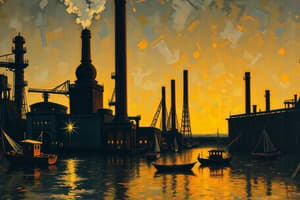Podcast
Questions and Answers
Flashcards
Industrial Revolution
Industrial Revolution
A period of rapid technological advancement and societal change, marked by the mechanization of production and the rise of factories.
Middle Class
Middle Class
A new social class that emerged during the Industrial Revolution, consisting of factory owners, merchants, and professionals who gained economic and political power.
Working Class
Working Class
A social class that emerged during the Industrial Revolution, consisting of factory workers, laborers, and miners who worked for the middle class.
Company Towns
Company Towns
Signup and view all the flashcards
Family Dynamics
Family Dynamics
Signup and view all the flashcards
Specialized Labor
Specialized Labor
Signup and view all the flashcards
Steam Engine
Steam Engine
Signup and view all the flashcards
Railroads
Railroads
Signup and view all the flashcards
Study Notes
Industrial Revolution: Societal Changes
- The Industrial Revolution, starting in the 18th century in Britain, transformed Western society, impacting class structure, family dynamics, and transportation.
- Urban areas and industrial cities grew, leading to the emergence of the middle class, comprised mostly of factory owners.
- The working class, often poor, faced harsh living conditions in company towns.
- Wealth disparity increased between social classes, creating divisions in society.
- Family dynamics changed. Lower classes had children working to supplement income, whereas upper classes focused on education.
Transportation Innovations
- Innovations in transportation (like steam engines, railroads, canals) improved efficiency and connected markets.
- Railroads and canals facilitated the movement of goods and people, boosting economic growth.
- Cost-effective transportation options opened up new markets.
Studying That Suits You
Use AI to generate personalized quizzes and flashcards to suit your learning preferences.




